University Report: Clinical Simulation Training in Healthcare
VerifiedAdded on 2022/08/29
|5
|921
|35
Report
AI Summary
This report delves into the significance of clinical simulation training within healthcare education. It highlights the advantages of simulation-based clinical education, emphasizing its role in mitigating medical errors and enhancing patient safety. The paper discusses the need for simulation training to provide hands-on experience, improve clinical competence, and reduce the risk of patient harm, especially for newly enrolled healthcare professionals. It also examines the learning theories that underpin simulation training, contrasting traditional cognitivist approaches with the constructivist model that emphasizes experiential learning. The report concludes by recommending the integration of multiple learning styles for comprehensive clinical education, supported by relevant research and academic sources. The report emphasizes the use of simulated patient models and their technological advancements to create realistic training scenarios.
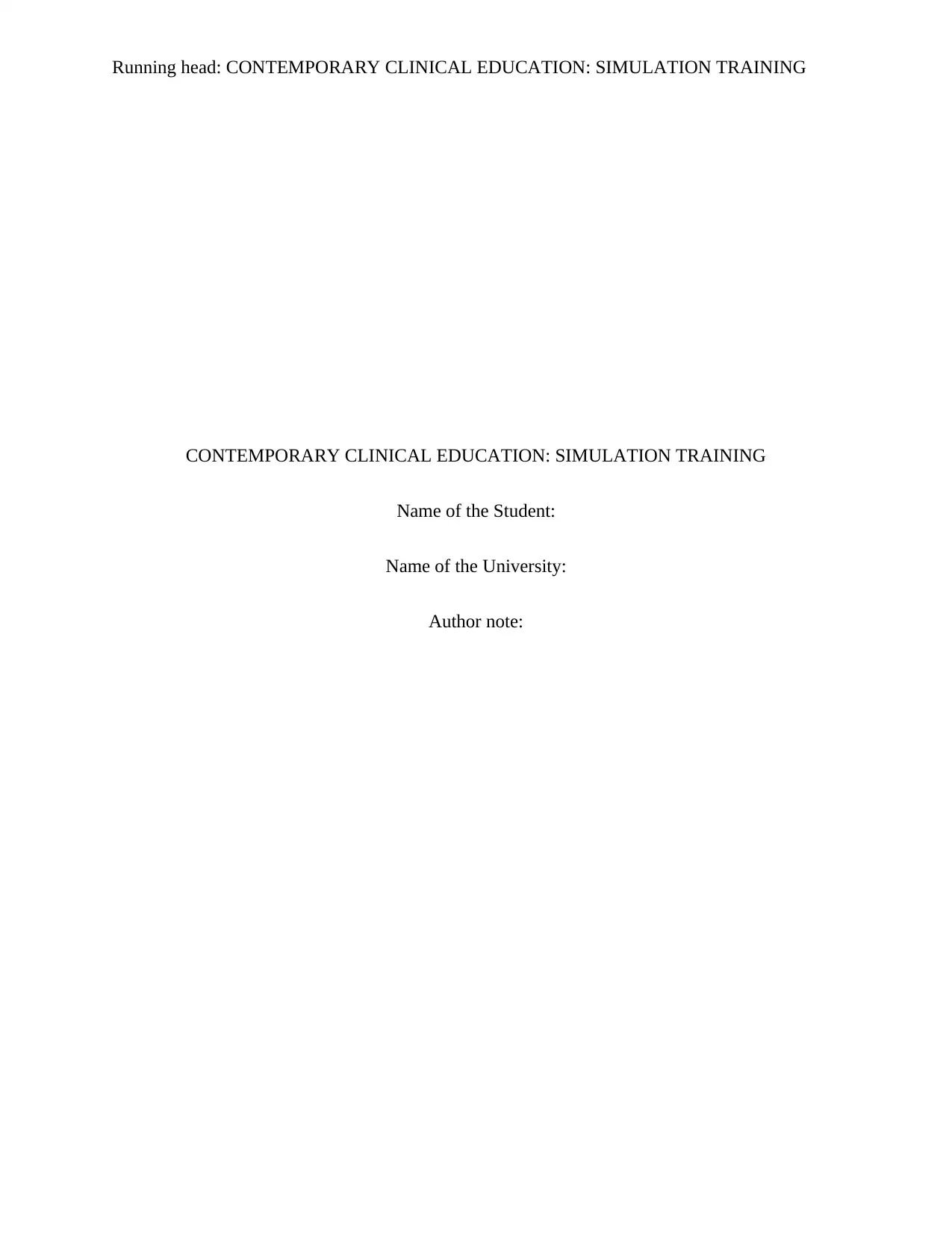
Running head: CONTEMPORARY CLINICAL EDUCATION: SIMULATION TRAINING
CONTEMPORARY CLINICAL EDUCATION: SIMULATION TRAINING
Name of the Student:
Name of the University:
Author note:
CONTEMPORARY CLINICAL EDUCATION: SIMULATION TRAINING
Name of the Student:
Name of the University:
Author note:
Paraphrase This Document
Need a fresh take? Get an instant paraphrase of this document with our AI Paraphraser
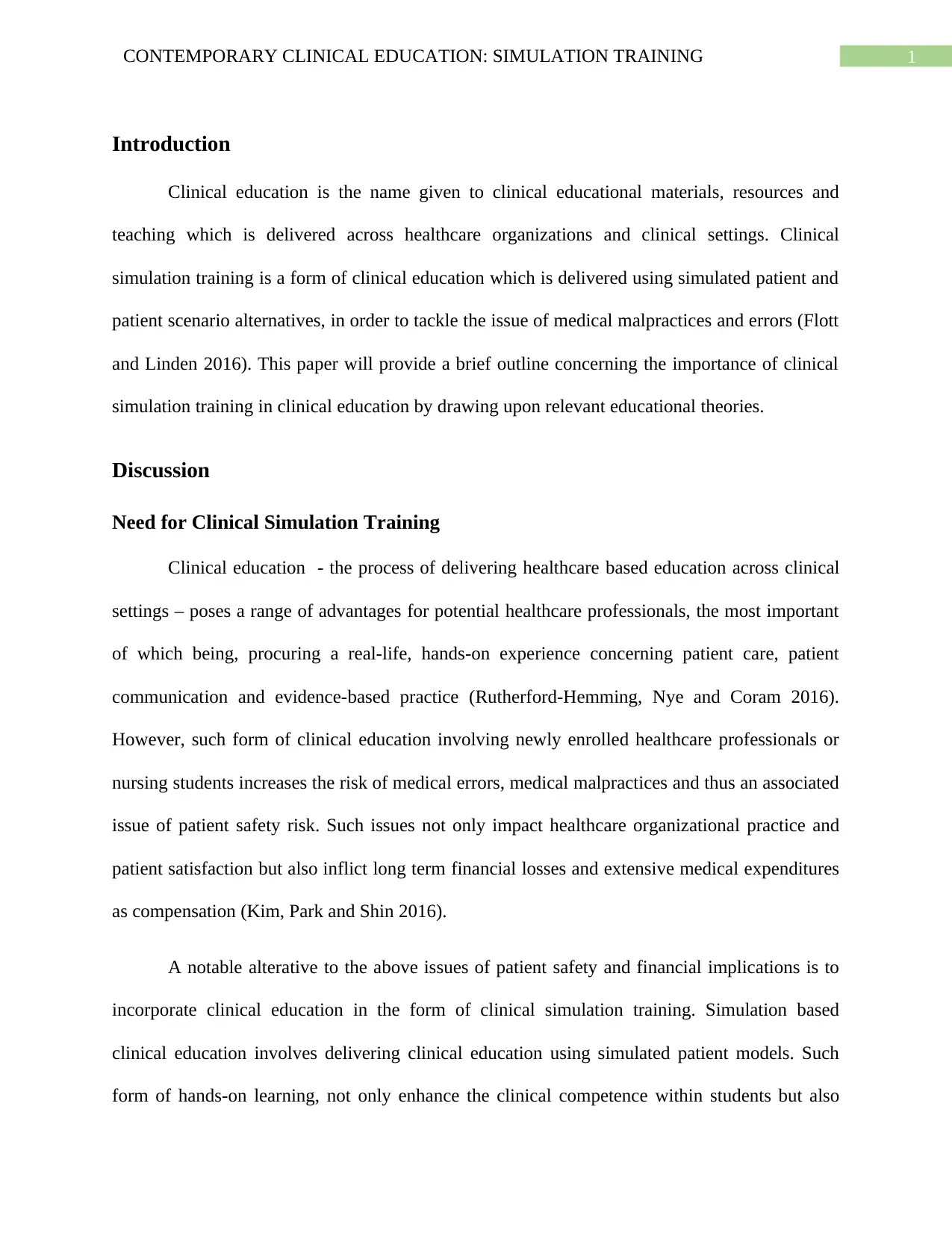
1CONTEMPORARY CLINICAL EDUCATION: SIMULATION TRAINING
Introduction
Clinical education is the name given to clinical educational materials, resources and
teaching which is delivered across healthcare organizations and clinical settings. Clinical
simulation training is a form of clinical education which is delivered using simulated patient and
patient scenario alternatives, in order to tackle the issue of medical malpractices and errors (Flott
and Linden 2016). This paper will provide a brief outline concerning the importance of clinical
simulation training in clinical education by drawing upon relevant educational theories.
Discussion
Need for Clinical Simulation Training
Clinical education - the process of delivering healthcare based education across clinical
settings – poses a range of advantages for potential healthcare professionals, the most important
of which being, procuring a real-life, hands-on experience concerning patient care, patient
communication and evidence-based practice (Rutherford-Hemming, Nye and Coram 2016).
However, such form of clinical education involving newly enrolled healthcare professionals or
nursing students increases the risk of medical errors, medical malpractices and thus an associated
issue of patient safety risk. Such issues not only impact healthcare organizational practice and
patient satisfaction but also inflict long term financial losses and extensive medical expenditures
as compensation (Kim, Park and Shin 2016).
A notable alterative to the above issues of patient safety and financial implications is to
incorporate clinical education in the form of clinical simulation training. Simulation based
clinical education involves delivering clinical education using simulated patient models. Such
form of hands-on learning, not only enhance the clinical competence within students but also
Introduction
Clinical education is the name given to clinical educational materials, resources and
teaching which is delivered across healthcare organizations and clinical settings. Clinical
simulation training is a form of clinical education which is delivered using simulated patient and
patient scenario alternatives, in order to tackle the issue of medical malpractices and errors (Flott
and Linden 2016). This paper will provide a brief outline concerning the importance of clinical
simulation training in clinical education by drawing upon relevant educational theories.
Discussion
Need for Clinical Simulation Training
Clinical education - the process of delivering healthcare based education across clinical
settings – poses a range of advantages for potential healthcare professionals, the most important
of which being, procuring a real-life, hands-on experience concerning patient care, patient
communication and evidence-based practice (Rutherford-Hemming, Nye and Coram 2016).
However, such form of clinical education involving newly enrolled healthcare professionals or
nursing students increases the risk of medical errors, medical malpractices and thus an associated
issue of patient safety risk. Such issues not only impact healthcare organizational practice and
patient satisfaction but also inflict long term financial losses and extensive medical expenditures
as compensation (Kim, Park and Shin 2016).
A notable alterative to the above issues of patient safety and financial implications is to
incorporate clinical education in the form of clinical simulation training. Simulation based
clinical education involves delivering clinical education using simulated patient models. Such
form of hands-on learning, not only enhance the clinical competence within students but also
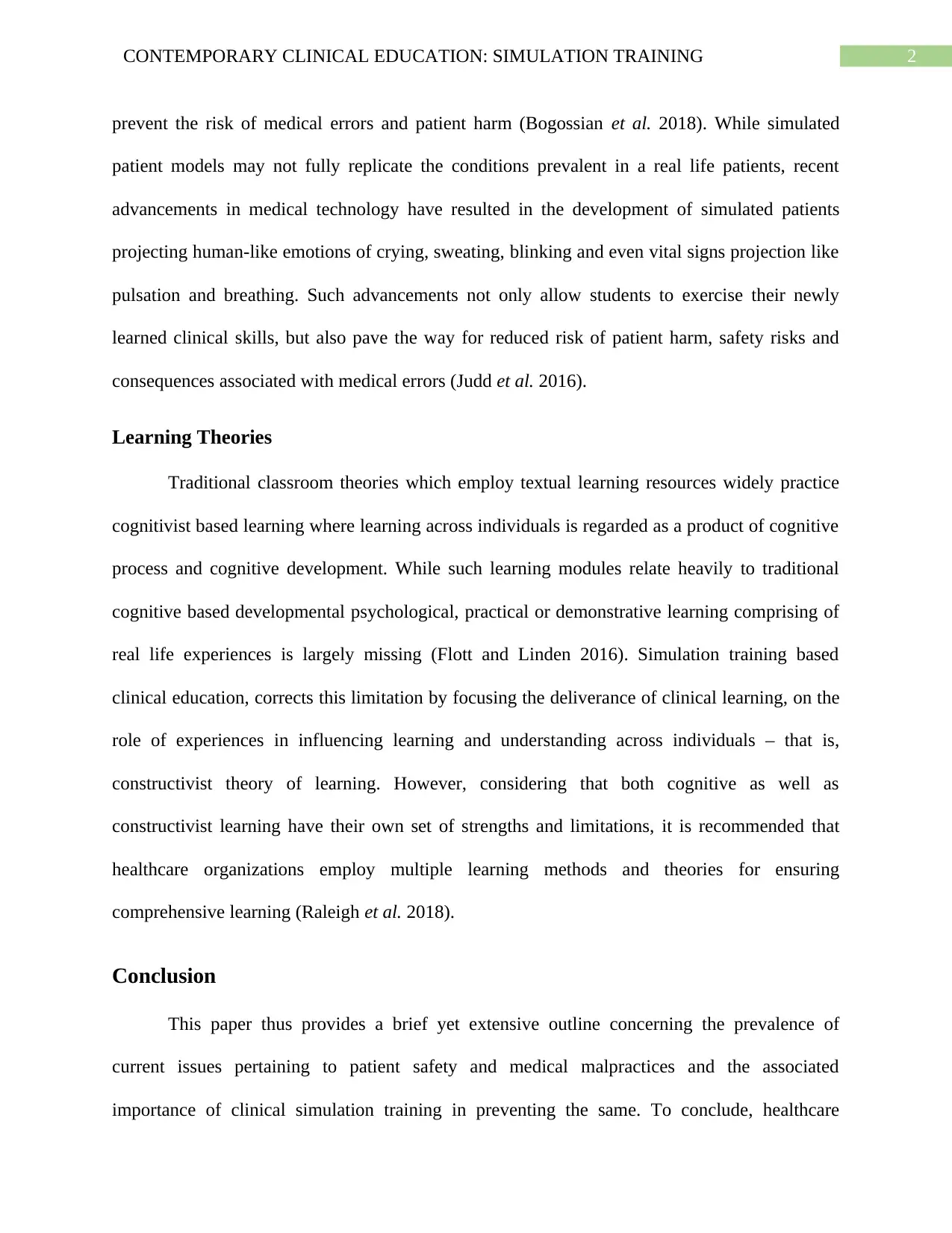
2CONTEMPORARY CLINICAL EDUCATION: SIMULATION TRAINING
prevent the risk of medical errors and patient harm (Bogossian et al. 2018). While simulated
patient models may not fully replicate the conditions prevalent in a real life patients, recent
advancements in medical technology have resulted in the development of simulated patients
projecting human-like emotions of crying, sweating, blinking and even vital signs projection like
pulsation and breathing. Such advancements not only allow students to exercise their newly
learned clinical skills, but also pave the way for reduced risk of patient harm, safety risks and
consequences associated with medical errors (Judd et al. 2016).
Learning Theories
Traditional classroom theories which employ textual learning resources widely practice
cognitivist based learning where learning across individuals is regarded as a product of cognitive
process and cognitive development. While such learning modules relate heavily to traditional
cognitive based developmental psychological, practical or demonstrative learning comprising of
real life experiences is largely missing (Flott and Linden 2016). Simulation training based
clinical education, corrects this limitation by focusing the deliverance of clinical learning, on the
role of experiences in influencing learning and understanding across individuals – that is,
constructivist theory of learning. However, considering that both cognitive as well as
constructivist learning have their own set of strengths and limitations, it is recommended that
healthcare organizations employ multiple learning methods and theories for ensuring
comprehensive learning (Raleigh et al. 2018).
Conclusion
This paper thus provides a brief yet extensive outline concerning the prevalence of
current issues pertaining to patient safety and medical malpractices and the associated
importance of clinical simulation training in preventing the same. To conclude, healthcare
prevent the risk of medical errors and patient harm (Bogossian et al. 2018). While simulated
patient models may not fully replicate the conditions prevalent in a real life patients, recent
advancements in medical technology have resulted in the development of simulated patients
projecting human-like emotions of crying, sweating, blinking and even vital signs projection like
pulsation and breathing. Such advancements not only allow students to exercise their newly
learned clinical skills, but also pave the way for reduced risk of patient harm, safety risks and
consequences associated with medical errors (Judd et al. 2016).
Learning Theories
Traditional classroom theories which employ textual learning resources widely practice
cognitivist based learning where learning across individuals is regarded as a product of cognitive
process and cognitive development. While such learning modules relate heavily to traditional
cognitive based developmental psychological, practical or demonstrative learning comprising of
real life experiences is largely missing (Flott and Linden 2016). Simulation training based
clinical education, corrects this limitation by focusing the deliverance of clinical learning, on the
role of experiences in influencing learning and understanding across individuals – that is,
constructivist theory of learning. However, considering that both cognitive as well as
constructivist learning have their own set of strengths and limitations, it is recommended that
healthcare organizations employ multiple learning methods and theories for ensuring
comprehensive learning (Raleigh et al. 2018).
Conclusion
This paper thus provides a brief yet extensive outline concerning the prevalence of
current issues pertaining to patient safety and medical malpractices and the associated
importance of clinical simulation training in preventing the same. To conclude, healthcare
⊘ This is a preview!⊘
Do you want full access?
Subscribe today to unlock all pages.

Trusted by 1+ million students worldwide
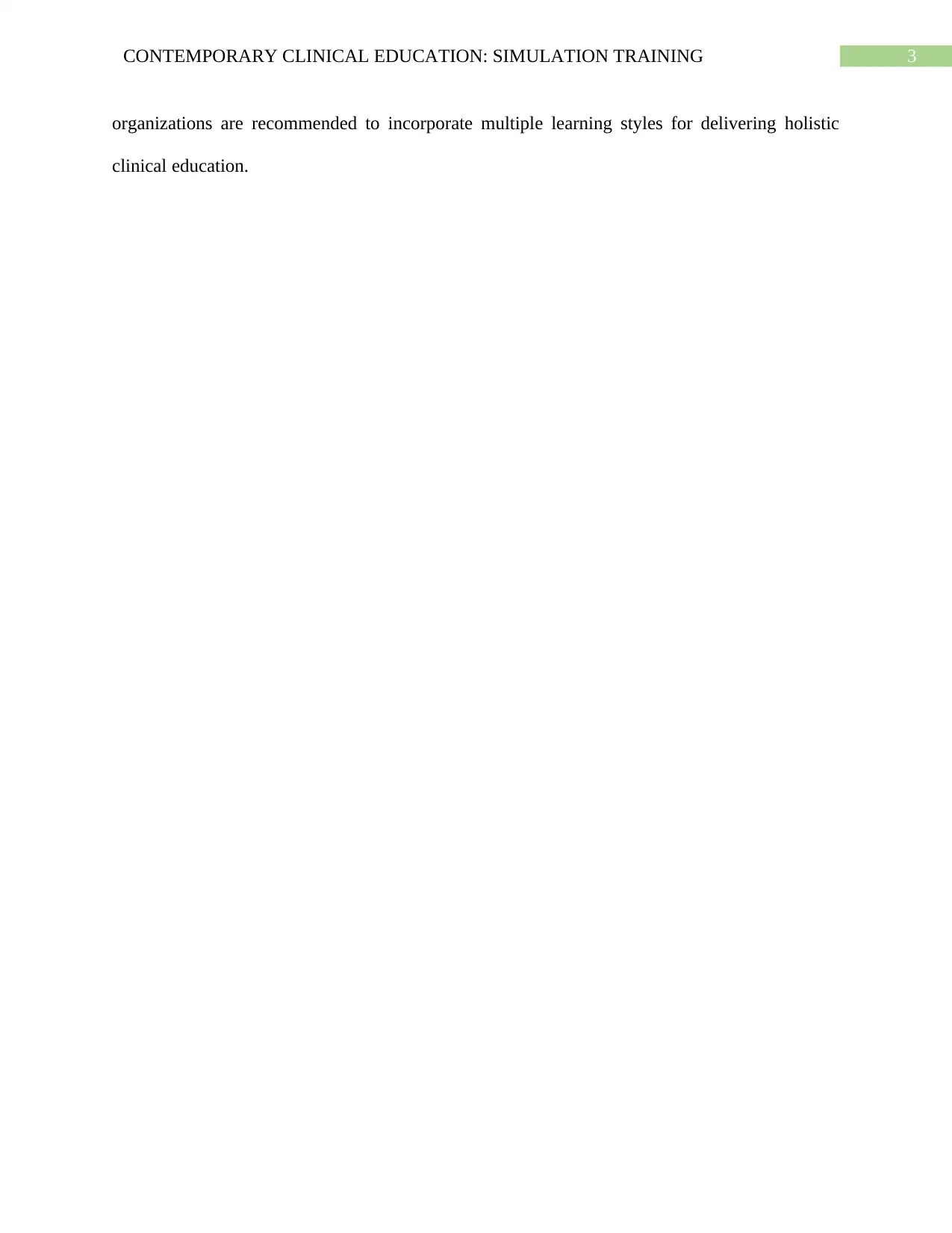
3CONTEMPORARY CLINICAL EDUCATION: SIMULATION TRAINING
organizations are recommended to incorporate multiple learning styles for delivering holistic
clinical education.
organizations are recommended to incorporate multiple learning styles for delivering holistic
clinical education.
Paraphrase This Document
Need a fresh take? Get an instant paraphrase of this document with our AI Paraphraser
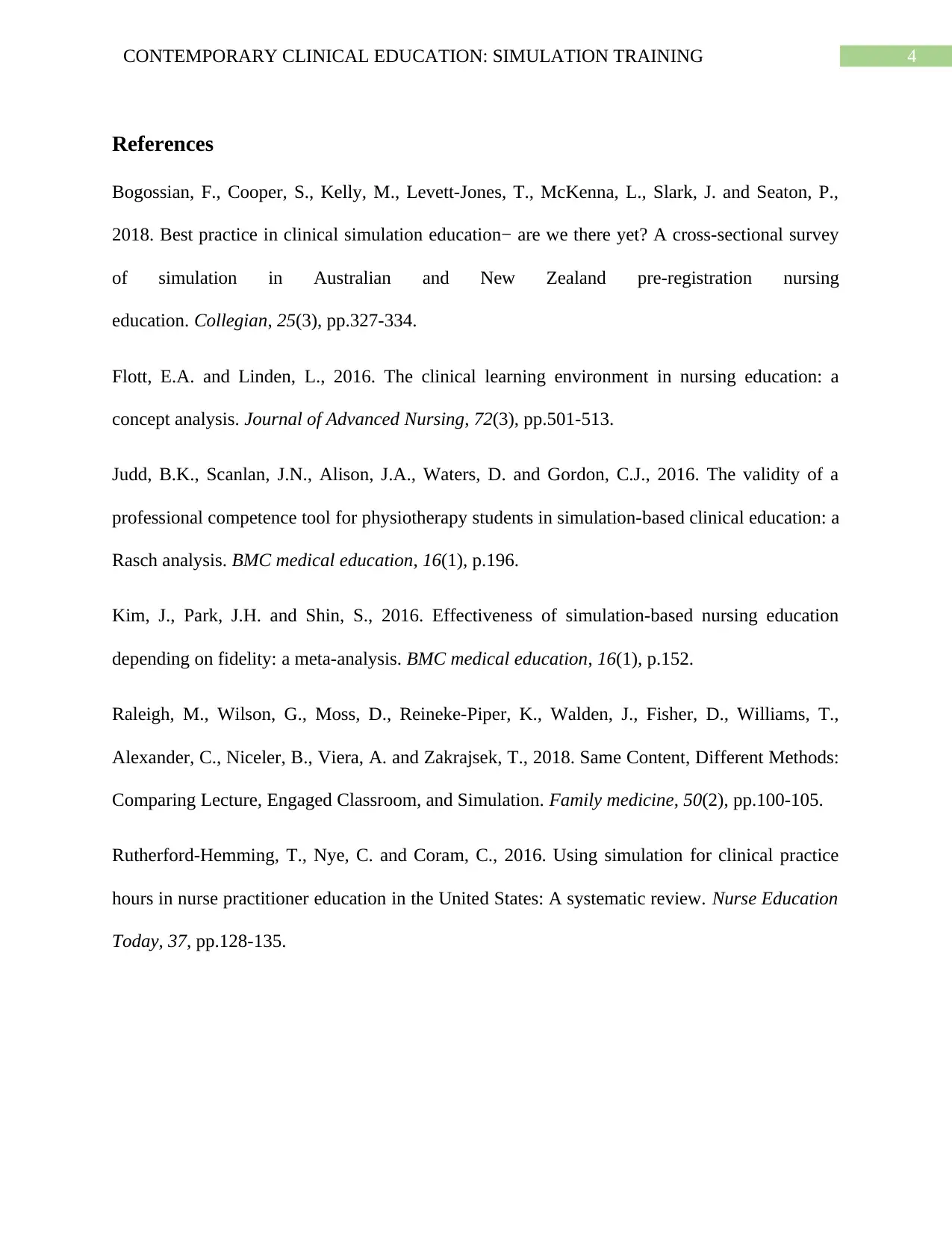
4CONTEMPORARY CLINICAL EDUCATION: SIMULATION TRAINING
References
Bogossian, F., Cooper, S., Kelly, M., Levett-Jones, T., McKenna, L., Slark, J. and Seaton, P.,
2018. Best practice in clinical simulation education− are we there yet? A cross-sectional survey
of simulation in Australian and New Zealand pre-registration nursing
education. Collegian, 25(3), pp.327-334.
Flott, E.A. and Linden, L., 2016. The clinical learning environment in nursing education: a
concept analysis. Journal of Advanced Nursing, 72(3), pp.501-513.
Judd, B.K., Scanlan, J.N., Alison, J.A., Waters, D. and Gordon, C.J., 2016. The validity of a
professional competence tool for physiotherapy students in simulation-based clinical education: a
Rasch analysis. BMC medical education, 16(1), p.196.
Kim, J., Park, J.H. and Shin, S., 2016. Effectiveness of simulation-based nursing education
depending on fidelity: a meta-analysis. BMC medical education, 16(1), p.152.
Raleigh, M., Wilson, G., Moss, D., Reineke-Piper, K., Walden, J., Fisher, D., Williams, T.,
Alexander, C., Niceler, B., Viera, A. and Zakrajsek, T., 2018. Same Content, Different Methods:
Comparing Lecture, Engaged Classroom, and Simulation. Family medicine, 50(2), pp.100-105.
Rutherford-Hemming, T., Nye, C. and Coram, C., 2016. Using simulation for clinical practice
hours in nurse practitioner education in the United States: A systematic review. Nurse Education
Today, 37, pp.128-135.
References
Bogossian, F., Cooper, S., Kelly, M., Levett-Jones, T., McKenna, L., Slark, J. and Seaton, P.,
2018. Best practice in clinical simulation education− are we there yet? A cross-sectional survey
of simulation in Australian and New Zealand pre-registration nursing
education. Collegian, 25(3), pp.327-334.
Flott, E.A. and Linden, L., 2016. The clinical learning environment in nursing education: a
concept analysis. Journal of Advanced Nursing, 72(3), pp.501-513.
Judd, B.K., Scanlan, J.N., Alison, J.A., Waters, D. and Gordon, C.J., 2016. The validity of a
professional competence tool for physiotherapy students in simulation-based clinical education: a
Rasch analysis. BMC medical education, 16(1), p.196.
Kim, J., Park, J.H. and Shin, S., 2016. Effectiveness of simulation-based nursing education
depending on fidelity: a meta-analysis. BMC medical education, 16(1), p.152.
Raleigh, M., Wilson, G., Moss, D., Reineke-Piper, K., Walden, J., Fisher, D., Williams, T.,
Alexander, C., Niceler, B., Viera, A. and Zakrajsek, T., 2018. Same Content, Different Methods:
Comparing Lecture, Engaged Classroom, and Simulation. Family medicine, 50(2), pp.100-105.
Rutherford-Hemming, T., Nye, C. and Coram, C., 2016. Using simulation for clinical practice
hours in nurse practitioner education in the United States: A systematic review. Nurse Education
Today, 37, pp.128-135.
1 out of 5
Related Documents
Your All-in-One AI-Powered Toolkit for Academic Success.
+13062052269
info@desklib.com
Available 24*7 on WhatsApp / Email
![[object Object]](/_next/static/media/star-bottom.7253800d.svg)
Unlock your academic potential
Copyright © 2020–2025 A2Z Services. All Rights Reserved. Developed and managed by ZUCOL.





